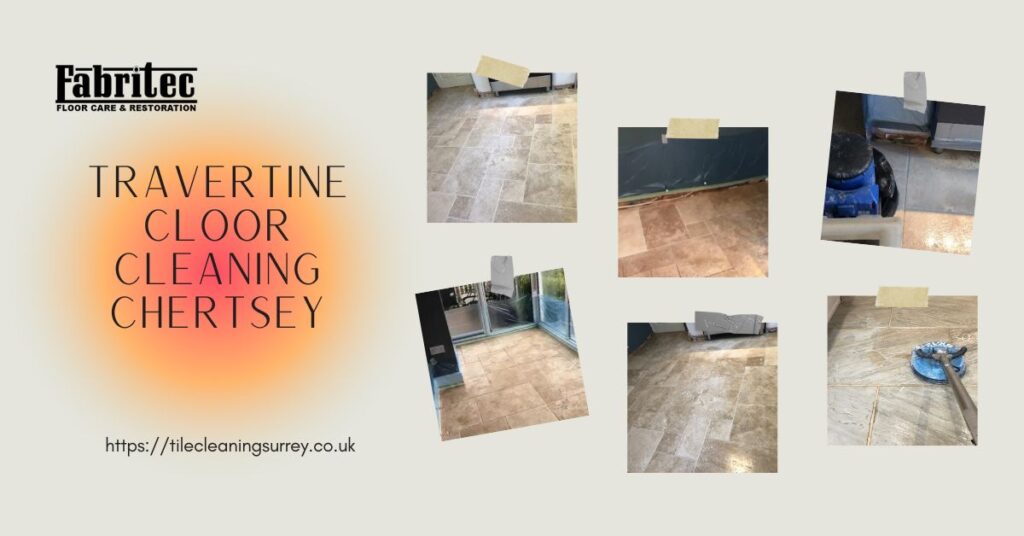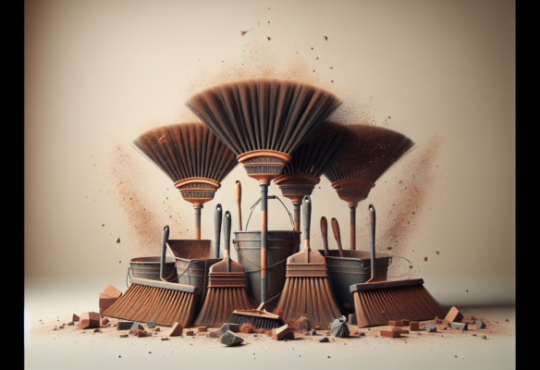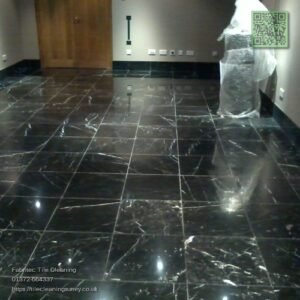
Cleaning and Sealing a Travertine Floor in Chertsey, Surrey

Background
Travertine floors are known for their natural beauty and unique appearance, but they require proper care and maintenance to maintain their charm over time. Recently, we had the opportunity to revitalise a well-worn travertine floor in a residential property in Chertsey, Surrey. This case study will illustrate the steps we followed to clean, repair, and seal the travertine floor, ensuring it not only looked new but also would last for years to come.
Initial Assessment and Preparation
Upon initial inspection, the travertine floor showed signs of wear, including visible dirt buildup in the grout lines, small natural holes typical of travertine stone, and some minor cracks in a few tiles. To ensure a clear workspace, we removed all furniture from the area before vacuuming up any loose debris and dust.
To protect surrounding surfaces, such as kitchen units and adjacent floors, we applied protective sheeting. This is critical in preventing any potential damage from cleaning agents or equipment during the cleaning process.
Deep Cleaning the Travertine Tiles and Grout
The key to revitalising travertine is a thorough, deep cleaning process. We started by applying a diluted, professional-grade travertine cleaner across the floor, paying special attention to grout lines and any heavily soiled areas. After allowing the cleaner to sit for about ten minutes to loosen embedded dirt, we used a rotary scrubbing machine to work the cleaner into the tiles.
This method effectively lifted the grime that had accumulated over time, leaving the surface visibly cleaner. To ensure the floor was completely clean, we followed up with pressure rinsing, a crucial step for removing any remaining cleaning slurry and debris. The rinse also eliminated any residues from previous sealers, preparing the surface for repair and sealing.
Repairing the Travertine Tiles
Upon cleaning, we discovered a few natural holes and minor cracks in the travertine tiles, common in this type of stone. To address these issues:
Filling Holes:
We filled the natural holes using high-quality beige fillers that blended well with the existing tile colour. This step not only restored the uniformity of the floor but also prevented future dirt buildup in these crevices.
Repairing Cracks
For the cracked tiles, we used a resin grout that allows for slight movement without causing additional cracks. Colour-matching the grout to the tile ensured that the repairs were almost invisible, maintaining the floor’s seamless aesthetic.
Sealing the Travertine Floor
The final, yet most critical, step in this process was sealing the travertine floor. Sealing protects the stone from stains, spills, and everyday wear and tear, thus extending the floor’s life. For this project, we applied a high-solids, breathable sealer that not only penetrated the travertine but also formed a protective barrier on the surface.
Our client preferred a satin finish, which enhanced the natural beauty of the travertine without making it overly glossy. After the sealer was applied, we allowed it to cure for several hours, ensuring the floor was ready for regular use.
Aftercare Recommendations
To maintain the travertine’s refreshed appearance, we advised the client to follow a regular cleaning routine:
- Use a pH-neutral cleaner specifically designed for sealed natural stone, such as LTP Floorshine, to avoid damaging the sealer.
- Regularly vacuum or dust the floor to prevent dirt from scratching the surface.
- Immediately clean up any spills to prevent staining.
- Reapply the sealer every 2 to 3 years, depending on foot traffic, to maintain the floor’s protection and appearance.
Outcome
After completing the cleaning, repairing, and sealing processes, the travertine floor in the Chertsey property was transformed. The floor now had a renewed lustre, the grout lines were clean, and the repaired cracks were barely noticeable. The client was delighted with the results, and the floor was protected against future damage, ensuring it would remain beautiful for years to come.
We couldn’t be happier with the results! Our travertine floor looks absolutely stunning—like it’s brand new again. The team was professional, thorough, and took great care to restore every detail. We’re thrilled with how well the repairs blend in, and the sealing has made cleaning so much easier. Highly recommend their service!
This project highlights the importance of regular professional maintenance for travertine flooring to preserve both its aesthetic appeal and functional longevity.
Frequently Asked Questions
How Often Should I Clean My Travertine Tiles?
Cleaning travertine tiles should occur regularly, ideally once or twice a week, depending on foot traffic. Additionally, deep cleaning every six months guarantees the maintenance of their aesthetic appeal and longevity. Always use appropriate cleaners.
Can I Use Vinegar to Clean Travertine Surfaces?
Using vinegar to clean travertine surfaces is not advisable, as its acidity can damage the stone and its protective seal. Instead, opt for a pH-balanced cleaner specifically formulated for natural stone to maintain its integrity.
What Are Common Signs of Travertine Damage?
Common signs of travertine damage include visible cracks, chips, discoloration, and uneven surfaces. Additionally, persistent stains or dullness indicate wear, necessitating immediate attention to maintain both the aesthetics and structural integrity of the flooring.
Is Travertine Suitable for Outdoor Use?
Travertine is suitable for outdoor use due to its durability and natural slip resistance. However, proper sealing is essential to protect it from weathering and staining, ensuring longevity and maintaining its aesthetic appeal in outdoor environments.
How Can I Prevent Future Staining on Travertine?
To prevent future staining on travertine, apply a high-quality sealer regularly, promptly clean spills, and utilise pH-neutral cleaners. Additionally, maintain a consistent cleaning routine to enhance the stone’s durability and aesthetic appeal.
The post: Travertine Cleaning Chertsey was produced by Travertine Floor Cleaning Chertsey
The Article Cleaning and Sealing a Travertine Floor in Chertsey, Surrey appeared first on https://fabritec.org
The Article Cleaning and Sealing a Travertine Floor in Chertsey, Surrey Was Found On https://limitsofstrategy.com
The Article Cleaning and Sealing a Travertine Floor in Chertsey, Surrey First Appeared ON
: https://ad4sc.com












It’s interesting to see the care that goes into maintaining travertine floors; they really do have a unique charm that can transform a space. I recently tackled a similar project in my own home, and I was surprised by how much dirt can accumulate in those tiny cracks and grout lines. It’s a reminder of how surfaces we take for granted can really tell a story about a space.
It’s pretty wild how something like travertine can lead to a whole journey of discovery in your own home, right? Those little cracks and crevices really do have a way of collecting bits of everyday life, don’t they? It’s almost like a timeline of what’s gone on in that space—the family gatherings, the spilled drinks, the cozy evenings spent just hanging out. It gives the floor a personality of its own.
I really resonate with what you’re saying about travertine and the stories it seems to hold. It’s fascinating to think of how our surroundings can reflect our lives in such subtle ways. You’re right—those little imperfections can tell a history, almost like a scrapbook that captures everyday joys and mishaps.
I’m glad you connected with that idea about travertine. It really does feel like the stone is a silent witness to all the life around it. There’s something deeply comforting in knowing that every little mark and smudge can tell a different story. It makes me think about how we often overlook the beauty in the imperfect things.
I really resonate with what you’re saying about travertine and how it captures little pieces of our story. It’s interesting to think about how even something as seemingly ordinary as flooring can reflect our experiences and moments. The way those cracks and crevices accumulate memories—like the laughter during family gatherings or the quiet evenings with a good book—adds so much character to a space.
It’s fascinating how something as simple as flooring can evoke such deep reflections. You captured the essence beautifully when you mentioned those “cracks and crevices.” Each one really does tell a story, doesn’t it? It’s almost like they’re little reminders of the life lived on them—the joy of a child’s first steps, the comfort of a shared meal, or even the solitude of a quiet night.
You’re so right about how those “cracks and crevices” can encapsulate so much of what we experience in life. It’s interesting to think about how flooring, something we often overlook, can hold these narratives that span generations. Each mark could represent a moment that, at the time, felt ordinary but in retrospect becomes a cherished memory.
It’s interesting you mention the cracks and crevices—it’s almost like they serve as tiny repositories of our daily lives, right? I’ve thought about how something like travertine can evoke so many memories just by being there. It’s almost like history etched into the floor.
It really is interesting how something as simple as flooring can hold so many memories and stories. That idea of little cracks and crevices collecting snippets of daily life makes me think about how our environments reflect the moments we’ve shared. I’ve noticed that in my own home; my kitchen tile has a spot where my daughter once dropped her favorite mug. It’s a small mark, but every time I see it, I think of that silly moment where everything just slowed down.
You’ve hit on something really important about travertine and, honestly, so many natural surfaces. They do have this incredible ability to tell stories through their textures and nuances, which often get overlooked in our daily hustle. It’s fascinating how a material can hold onto bits of history or evidence of life’s little moments, especially in those tiny cracks and grout lines you mentioned.
You bring up a really interesting point about natural surfaces like travertine. There’s something so grounding about the idea that these materials can carry stories within them. It makes me think about how we often rush through life, barely pausing to notice the details that really connect us to our surroundings. Those tiny cracks and differences in texture can remind us that nothing is perfect, and there’s beauty in the imperfections.
You’ve captured the essence of what makes natural materials like travertine so compelling. Each imperfection has its own story, a reminder of the passage of time and the forces of nature that shaped it. It’s interesting how our fast-paced lives often lead us to overlook these stories, yet they are everywhere around us if we take a moment to notice.
It’s great to hear about your experience tackling a similar project in your home. Travertine really does have that way of adding depth and personality to a space, doesn’t it? Those little fissures and crevices can definitely accumulate more dirt than you’d expect. It’s almost like they’re little archives holding onto the stories of everyday life, which I find kind of fascinating.
I completely agree with you on the way travertine adds character to a space. It has a kind of timeless quality that can make a room feel both inviting and serene. I’ve noticed that those little fissures really do tell a story; they seem to hold onto the life that happens around them. It’s interesting how different surfaces can invite different experiences and emotions.
It’s fascinating to read about your recent project involving the revitalization of a travertine floor, especially since these beautiful natural stones can carry so much character but require such vigilant care. Your thorough initial assessment indeed highlights the importance of understanding the specific needs of the material before diving into restoration. I think many homeowners overlook this step and might impulsively try to clean or restore without realizing the unique characteristics of travertine.
I completely agree with you about the importance of understanding the unique characteristics of materials like travertine. During the project, I was struck by how each piece tells a story—not just through its appearance but also through the history of its use. I think this really emphasizes the importance of preservation over mere restoration.
I recently came across a piece about restoring travertine floors that really emphasizes the care these beautiful stones need, which could be a game-changer for anyone looking to enhance their home’s character while staying mindful of the material’s unique properties.
‘Reviving Travertine Floors in Chessington, Surrey’
https://cable13.com/reviving-travertine-floors-in-chessington-surrey/.
I appreciate your thoughts on the travertine floor project. It really is a unique stone with so much history and character, isn’t it? I find the initial assessment stage fascinating because it’s almost like getting to know the material personally. Each piece of travertine has its own quirks, whether it’s natural pitting or variations in color, and understanding those nuances makes all the difference in restoration.
I completely agree with you about the unique character of travertine. It’s intriguing how each piece tells a part of its own story with those natural elements you mentioned. I often think of the ancient structures built from travertine, like the Colosseum in Rome, and how these stones have stood the test of time. It’s like holding a piece of history right underfoot.
You’re spot on about travertine and its character. Each piece really does have a story, shaped by years of natural processes. I find it fascinating how the same material found in ancient structures can still be appreciated and used creatively today. The Colosseum is certainly a testament not just to the durability of travertine but also to the ingenuity of Roman engineering.
It really is intriguing how each piece of travertine tells its own story, isn’t it? I’ve often found that the character of natural stones like this can bring so much warmth and authenticity to a space. The natural pitting and color variations really reflect the conditions in which they were formed, like little reminders of geological time and the processes that shaped them.
It’s interesting to see how much care goes into maintaining travertine floors! I’ve always loved how their natural beauty can elevate a home’s aesthetic. It made me think about the unique characteristics of natural stones—every piece tells its own story, with those small holes and imperfections adding to their charm.
I completely agree with you about the charm of travertine floors. There’s something so grounding about natural stone, and those little imperfections really do tell a story—like a history book beneath your feet. It fascinates me how each piece can vary in texture and color, making every space feel unique.
I recently came across some insights on restoring travertine floors, and it dives deep into how their unique characteristics can really enhance a home’s charm while keeping the natural beauty intact.
‘Reviving Travertine Floors in Chessington, Surrey’
https://cable13.com/reviving-travertine-floors-in-chessington-surrey/.
I really appreciate your thoughts on the beauty of travertine floors. You hit the nail on the head about those little imperfections—each one adds a layer of character that you just don’t find in synthetic options. It’s like having a part of nature right inside your home, which is something I find so appealing.
It’s really fascinating to see how much care and effort goes into revitalizing travertine floors, especially since they carry such a unique character with their natural imperfections. I love that you highlighted the importance of thorough assessment and preparation—you can’t rush into these things without understanding the specifics of what you’re dealing with.
It really is intriguing, isn’t it? The unique character of travertine floors comes from the natural imperfections and variations in the stone, which not only make each piece distinctive but also tell a bit of history. Each mark and vein can hint at where the stone originated and its journey over time.
I really enjoyed reading about the revitalization process of the travertine floor in Chertsey. It’s fascinating how much character these natural stones bring into a home, but it’s clear that they come with their unique set of challenges. Your detailing of the initial assessment really highlights the importance of understanding the specific needs of the material before diving into cleaning and repairs.
Your detailed account of the travertine floor restoration process highlights some crucial aspects of maintaining natural stone surfaces, which many homeowners often overlook. The beauty of travertine, with its unique characteristics, can indeed be a significant aesthetic asset in any home, yet as you’ve illustrated, without proper maintenance, its allure can quickly fade.
I’m glad you found the account of travertine floor restoration valuable. It’s true that many homeowners don’t realize just how vital proper care is for maintaining the beauty of these surfaces. Travertine has such a distinctive charm, but it does require a little attention to keep it looking its best.
Your insights into the upkeep of travertine floors really resonate with the challenges many homeowners face. I’ve always admired the natural beauty of travertine, but I often worry about its maintenance, especially regarding the grout lines and those pesky natural holes. It’s fascinating how something as seemingly straightforward as regular cleaning can make such a significant difference in the longevity of these floors.
Your detailed account of the travertine floor revitalization process is both fascinating and insightful. It’s interesting how natural materials like travertine can truly transform a space, yet they demand such careful attention to maintain their beauty. I find it remarkable how a thorough cleaning and proper sealing can breathe new life into surfaces that may seem beyond repair.
It’s great to hear that you found the travertine floor revitalization process so intriguing. Natural materials do have a unique way of adding character to our spaces, don’t they? The beauty lies not just in their appearance but also in the rich history each piece carries.
This case study on revitalizing travertine floors highlights the importance of thorough assessments and careful preparation in maintenance work. It’s interesting how travertine, with its natural beauty, requires such specialized attention to preserve its charm. In my experience with stone surfaces, I’ve found that the right sealing product can significantly prolong the life of the flooring, protecting against stains and wear without compromising the aesthetic.
It’s fascinating to see the meticulous process you undertook to revitalize the travertine floor. The challenge of maintaining such natural stone surfaces is indeed significant due to their porous nature and susceptibility to damage. Your emphasis on the initial assessment is crucial; it reminds me of how vital it is to understand the specific needs of different materials before undertaking restoration work.